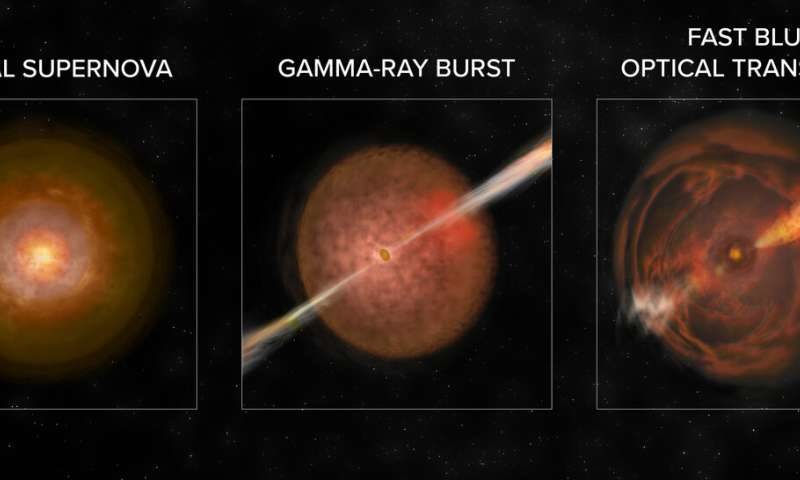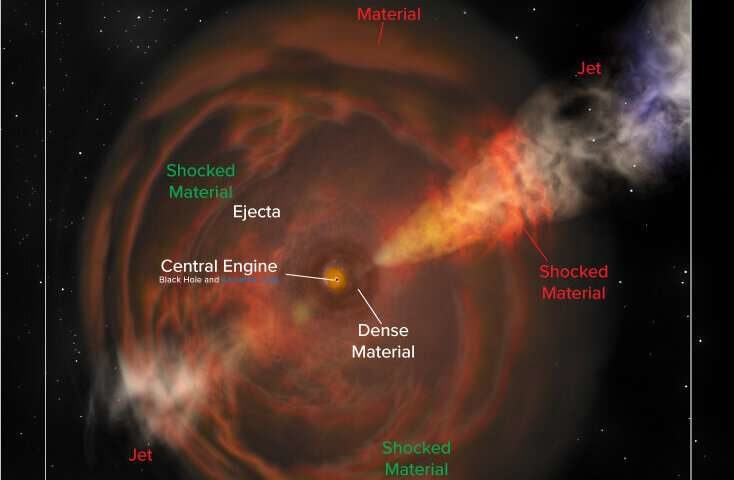The 'Koala,' which is a nickname derived from the tail end of its official name ZTF18abvkwla, suddenly appeared as a bright new source in the optical sky before disappearing within just a few nights. A team of astronomers at Caltech realized this behavior was similar to the 'Cow' and requested radio observations to see if the two were connected.
"When I reduced the data, I thought I made a mistake," said Anna Ho, graduate student of astronomy at Caltech and lead author of the study. "The 'Koala' resembled the 'Cow' but the radio emission was ten times brighter — as bright as a gamma-ray burst!"
Ho and her research team's paper is published in today's issue of The Astrophysical Journal.
Another cosmic explosion of this type, CSS161010, fascinated a team of astronomers led by Northwestern University. Based on radio observations, they calculated this transient launched material into space faster than 0.55 times the speed of light.
"This was unexpected," said Deanne Coppejans, postdoctoral associate at Northwestern University and lead author of the study on CSS161010. "We know of energetic stellar explosions that can eject material at almost the speed of light, specifically gamma-ray bursts, but they only launch a small amount of mass — about 1 millionth the mass of the Sun. CSS161010 launched 1 to 10 percent the mass of the Sun to relativistic speeds — evidence that this is a new class of transient!"
Coppejans and her team's paper is published in today's issue of The Astrophysical Journal Letters.
These three strange events make up a new subtype of FBOTs, which first dazzled the world in the summer of 2018 when the 'Cow,' short for AT2018cow, exploded in the sky.
Three months later, Ho's team captured the 'Koala.' Though the 'Cow' was the first to make world headlines, CSS161010 was actually the first FBOT discovered with luminous radio and X-ray emission, but astronomers did not know how to interpret these findings yet.
"At that time, there was really no theoretical model that predicted bright radio emission from bright FBOTs," said Coppejans. "It wasn't until we conducted follow-up radio and X-ray observations that the true nature of CSS161010 revealed itself. Seeing it at these wavelengths is important because the data showed we were looking at something new and highly energetic."
What makes these luminous FBOTs strange is they look like supernova explosions, but flare up and vanish much faster. They're also extremely hot, making them appear bluer in color than your standard supernovae.
Also, while these new FBOTs explosions are just as violent as long gamma-ray bursts (GRBs) and can also launch outflows at relativistic velocities, their observational signatures are different in that they are surrounded by a lot of circumstellar matter. And unlike GRBs, the 'Cow' and CSS161010 contain hydrogen.
"We don't see these two elements in GRB-supernova spectra because we think GRBs come from dying stars that were 'stripped' of their hydrogen and helium envelopes prior to collapsing into a new black hole," said Ho.

The two teams used Keck Observatory's Low Resolution Imaging Spectrometer (LRIS) and DEep Imaging and Multi-Object Spectrograph (DEIMOS) to characterize the host galaxies of the 'Koala' and CSS161010; they found both FBOTs come from low-mass dwarf galaxies, just like the 'Cow.'
"The host galaxy of CSS161010 is so small that only a 10-meter class telescope like Keck can collect enough light to allow us to physically model the emission," said co-author Giacomo Terreran, postdoctoral associate at Northwestern University's CIERA (Center for Interdisciplinary Exploration and Research for Astrophysics). "Remarkably, the Keck data showed the host galaxies of CSS161010, the 'Koala,' and the 'Cow,' while tiny, are actively forming stars, indicating their home base has a very small stellar mass typical of dwarf galaxies."
"This likely indicates the dwarf galaxy properties, such as the metallicity or formation history, might allow some very rare evolutionary paths of stars that lead to the most violent explosions," said Coppejans.
While both teams attribute the explosions of massive stars as the most likely cause of these new FBOTs, another possibility still under consideration is they originate from stars being devoured by black holes. If so, this new class of FBOTs could be key in the hunt for medium-sized black holes, which have yet to be detected. In general, the more massive a galaxy is, the heavier its central black hole; following this trend, it is expected that dwarf galaxies are candidates for hosting intermediate mass black holes.
"One idea is that FBOTs could be the flare of a star being ripped apart by an intermediate mass black hole. If this is the case, then they could potentially be beacons to help find these elusive black holes," said CSS161010 co-author Rafaella Margutti, assistant professor of physics and astronomy at Northwestern University and faculty member of Northwestern's CIERA.
While the origin of this type of FBOT is still hotly debated, the new data provide fresh insight on how they may have formed.
"The observations prove the most luminous FBOTs have a 'central engine' — a source like a neutron star or black hole that powers the transient," said Margutti. "It's not yet clear if these bright FBOTs are rare supernovae, stars being shredded by black holes, or other energetic phenomena. Multi-wavelength observations of more FBOTs and their environment will answer this question."
Methodology and Next Steps
Due to their extremely rapid rise to maximum light, these rare FBOTs are difficult to detect. But recent developments in high-cadence optical surveys scanning huge swaths of the sky every night make the hunt for rare, short-duration transients more feasible. The key to determining their true nature is to conduct follow-up multi-wavelength observations.
The 'Koala' was first detected using the Zwicky Transient Facility at Palomar Observatory. Ho's team then used the Hale Telescope to obtain spectra, followed by the Very Large Array (VLA) and the Giant Metrewave Radio Telescope (GMRT) to conduct radio observations.
CSS161010 was first captured by the Catalina Real-time Transient Survey and independently discovered by the All-Sky Automated Survey for Supernovae. Coppejans and her team then conducted follow-up radio observations with the VLA and GMRT, and X-ray observations with NASA's Chandra X-ray Observatory.
The radio emission is produced by the shock wave of the material slamming into the surrounding medium at more than 0.55 times the speed of light, but the X-ray emission cannot be explained this way. The team speculates they might be directly seeing the central engine in X-rays, like in the 'Cow.'
"One lesson learned is while FBOTs have proven rarer and harder to find than some of us were hoping, in the radio band they're also much more luminous than we'd guessed, allowing us to provide quite comprehensive data even on events that are far away," said Daniel Perley, senior lecturer at Liverpool John Moores University's Astrophysics Research Institute and co-author of the 'Koala' study.
"These observations of the 'Koala' and CSS161010 show how much we can learn from radio and X-ray observations of FBOTs," said Ho. "The challenge going forward is to delineate different FBOT subtypes and to develop more precise vocabulary. It's exciting to help investigate a new and unexpected phenomenon. In science, you sometimes don't find what you were expecting to find, but along the way you uncover new directions."
Astrophysicists capture new class of transient objects More information: Anna Y. Q. Ho et al. The Koala: A Fast Blue Optical Transient with Luminous Radio Emission from a Starburst Dwarf Galaxy at z = 0.27, The Astrophysical Journal (2020). DOI: 10.3847/1538-4357/ab8bcf
D. L. Coppejans et al. A Mildly Relativistic Outflow from the Energetic, Fast-rising Blue Optical Transient CSS161010 in a Dwarf Galaxy, The Astrophysical Journal (2020). DOI: 10.3847/2041-8213/ab8cc7
Journal information: Astrophysical Journal , Astrophysical Journal Letters




RC